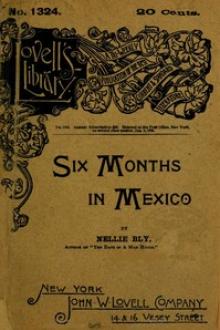Six Months in Mexico by Nellie Bly (best classic literature TXT) 📕

- Author: Nellie Bly
- Performer: -
Book online «Six Months in Mexico by Nellie Bly (best classic literature TXT) 📕». Author Nellie Bly
The horse on which the picador is mounted is bought only to be killed. It is an old beast whose days of beauty and usefulness are over; $2 or $4 buys him for the purpose. Sometimes he is hardly able to walk into the ring. First the brute is blindfolded with a leather band, and a leather apron is fastened around his neck in pretense of saving him from being gored.
The picador guides the blinded horse to face the bull. Capas are flung before the bull tauntingly. The picador drives the pica into the beast and it vents its pain on the horse. Blood pours from the wound; trembling the horse stands, unable to see what has wounded it. Again they coax the bull to charge, and place the horse so that the murderous horns will disembowel it. Down goes the blinded beast, and the capeadores flaunt their capas at the bull while the picadore gets off the dying animal, which is lassoed and dragged from the ring. Another horse is brought in, and the same work is gone over until the horse is killed.
Every bull is allowed to kill two horses, and then the people shout “Muerie! muerie!” (Kill the bull.) The judge gives the command and the matador bows to the judge, and then teases the bull with his red capa. The laws prohibit a fighter to strike a bull until it first charges, and the bull has the chance of three charges at the matador before he dares to strike. The bull never appears to see the man by his side, but furiously fights the red capa held before him. El capitan then plunges the sword into the neck between the shoulders and through to the heart, if deftly done, after which the bull staggers, protrudes its tongue, tries to find a door for escape, stumbles and dies. Again the people shout, and the matador, as he makes his bow to the judge, is thrown money, cigars, fruit, flowers and other favors. Men fling in their $50 and $100 sombreros, and consider it a great honor when he picks them up and tosses them back. During all this the three mules are brought in. At the sight of the dead bull they plunge and tear, but are finally hitched to it. The clowns jump on the dead beast, and it is hauled from the ring.
When the bull is tame and, though tortured on all sides, still refuses to gore the horse, the people hiss and shout “lazadore,” until the judge gives the command for the brute, that is more humane than its tormentors, to be removed and replaced by one that will sate their feverish desire for blood. Now is the time for the lazadores to get in some pretty work. The space is small and cramped. but with a deftness that is bewildering they throw the loop over the horns. The knowing horse dodges, the bull loses his balance and the horse gives a sudden jerk, throwing the bull on the ground. He is then allowed to arise and is started around the ring at a merry gallop, while the second lazadore exhibits great skill in lassoing the feet, front and back, of the running beast.
The bull, after being thrown, realizes he is at their mercy, and lies passive; or trembling with fear and pain, while the brutal clowns spring astride the prostrated beast, and with no gentle hand tear the banderillas from the quivering flesh, which, still warm and dripping with blood, are sold as trophies at one and two dollars each. Then the butcher steps forth and with a sharp knife cuts the spinal cord, and the beast is done for. When a bull refuses to fight before he is cut, except for wounds from the pica and banderillas, the people cry in Spanish, “He is a weak woman,” until the judge orders his removal. It is difficult work, and affords much fun for the Mexicans, for the bull must be forced back into the dark cell whence he came.
One fight consists of four bulls and as many old horses as they can be compelled to kill. A bull is not considered much unless he can kill, at the very least, two horses. The poor horses are very seldom killed instantly. When wounded so that it is impossible for them to walk, they are dragged from the ring and left in a vacant field, where they die that night or the following day, as the Mexicans do not consider them worth a bullet. The bull finds more mercy. If not killed outright by the matador, a butcher finishes the work, and ends the misery. When stabbed fatally he often staggers along the fence, as though in hopes of finding an exit. The cruel spectators are not satisfied that he is dying, and allow him some little mercy, but stab his wounded flesh, tear open his death wound, twist his tail, do all in their power to enhance his sufferings until he falls dead. One would suppose the heated, tortured, wounded beef would be of no account, but such is not the case. Before many hours, after taken from the scene of its death, the beef is being sold to the people, who buy it without the least hesitancy or disgust, even boasting that they eat of the bull that killed so many horses, and if it happened to kill a man it is considered an honor to eat of it. This makes an American want little beef, and that little covered with red pepper to kill the taste. When seated opposite the entrance gate one has full view of the butcher at work. The hide is taken off the toro immediately, and it is dissected. Then they commence on the horses, but they claim the horses’ flesh is not sold for beef.
At some fights the spectators are favored with a performer, who allows the maddened toro to attack him, when, by the aid of a long pole, he jumps clear over it. This is a dangerous and, many times, a fatal leap, but is a favorite sight of the people.
After the fight comes the toro embolado. A bull with balls on its horns is led in. All the paid fighters leave the ring and any one among the spectators who has a desire to try the sport can do so. The number is not few, and the sight is really funny. They wave their serapes at the bull, who, in return, often tosses them on his horns. The lazadores prevent him from trampling them, and it is very seldom any one is killed, though broken arms and ribs are no unusual thing. This is the proudest day of the Mexican’s life when he gains access to the bull ring and can exhibit to people his activity and daring. The most risky amateur is then given a position as fighter, a position he considers greater than the presidency of the United States, and for which he would not exchange.
The government charges a license of $250 for each fight. If the bulls are tame the show is fined for giving a poor performance and swindling the people. The matador, El Capitan, whose duty it is to strike the bull’s heart with a sword, gets the highest salary, as much as $200 a performance; the other fighters receive from $10 to $100.
Sometimes a fight is given for charitable purposes. Young girls dressed like brides in white satin, veil and satin shoes, do all the directing, and young men of position and birth are the fighters.
It is to be supposed that when a man is killed in the ring the fight would stop, but that only seems to whet their desire for more blood, and a dead man is pulled off the field and another takes his place amid increased enthusiasm. At a fight two weeks ago one man was gored almost to death, another had his arm broken, and a woman, who had witnessed this from her seat, entered the ring and tried to kill the bull. She was caught on its horns and carried once around the ring and whirled around in her perilous position like a top. The audience shouted and was much disappointed when the bull cast the woman to the ground, devoid of clothing and badly bruised, but alive. At another fight three men were killed. Both times the spectators could hardly be forced to leave at the end of the performance. It is safe to assert that that beef sold at a high price.
Bernardo Javino, the man who was gored almost to death two weeks ago, has quite a history. He came from Spain fifty-one years ago, and is eighty-two years old, the oldest fighter in Mexico, and the most famous. He has fought in every bull ring in the republic, and has killed four thousand bulls. Senor Javino is a well-built, fine-looking fellow, and though but lacking eighteen years of one hundred is as strong as a man of thirty-five. He is a great favorite, and has received numerous and costly presents, among which he numbers one thousand fine bulls. But he is to-day very poor, and has only his salary. He is unmarried. Though the idol and favorite of the people, they shouted with joy when they saw him being gored. The bull caught him in the small of the back, and though making only one wound outside made five inside. He was carried off for dead, but though having a wound that would have finished any other man, he is still living, and asserts he will repay many bulls yet for his sufferings. The bull that had the honor to nearly finish the old warrior, killed three horses, broke the man’s arm, and almost finished the woman.
Senor Javino has a nephew, Juan Moreno, who gives promise of being the best fighter, after his uncle, in the Republic. He is a six-footer of magnificent build, with a handsome face, fair complexion, with brown hair, resembling a handsome American boy, in honor of which the Mexicans have named him El Americano (the American). Their shouts are long and long for El Americano, and presents are showered down on him. He can accomplish the daring feat of striking the bull’s heart with one thrust of the sword, which he withdraws instantly. This is considered scientific, for when the sword strikes the heart it is very difficult to withdraw, and is most always left sticking in until the bull dies. In the frontier the horns are sawed off the bulls before they go in the ring, in order to make the fight fierce and bloodier. It is said they are trying to stop this cruel torture.
The fight being finished the bands depart and the people make their way to the train with reluctance, where venders earn a mint of money by selling them pulque and a mixture of crushed corn and red pepper, done up in corn husks, which is eaten with a relish. After this Mexican feast is finished the train pulls out, everybody, men, women, and children, light their cigarettes, and between puffs they discuss the merits and demerits of the fight. The homeward trip is a very joyous one, so much so that “the daisy





Comments (0)